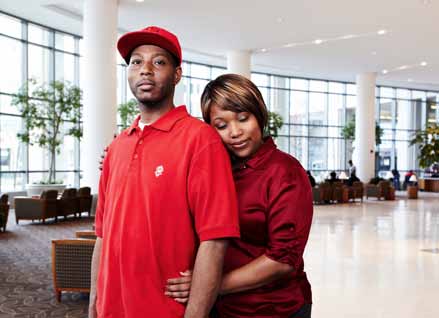Two planes landed in Pittsburgh for a landmark
PAIRED-KIDNEY EXCHANGE.
 |
| Despite not being a kidney donor-recipient match, Rebecca Burks, right, could donate a kidney and her fiance, Ken Crowder, could receive one thanks to a pilot kidney exchange at Barnes-Jewish Hospital. |
Ken Crowder was on the waiting list for a kidney transplant at Barnes-Jewish Hospital. Only 33, he had already been on dialysis for more than a year. His fiancée, Rebecca Burkes, a dialysis nurse who knew the toll of dialysis treatment on the patient’s body, was willing to donate her kidney to Crowder. But their blood types were not a match, so she couldn’t donate to him.
In New Hampshire, Kathy Niedzwiecki and Cathy Richard were in a similar situation. Niedzwiecki was on the waiting list at Dartmouth-Hitchcock Medical Center; her sister-in-law, Cathy Richard, was willing to donate but wasn’t a match. But tests showed that Burkes was a match for Niedzwiecki, and Richard matched Crowder.
These two donor-recipient pairs were able to swap kidneys, resulting in successful transplants for both patients on Dec. 6, 2010. This was the first paired kidney exchange (PKE) arranged through a national pilot program set up by the United Network for Organ Sharing (UNOS), the agency that oversees organ and tissue donation and allocation in the United States.
On that day, Washington University transplant surgeon Surendra Shenoy, MD, PhD, removed Burkes’ kidney in a third-floor operating room at Barnes-Jewish. The kidney was packed in ice, and Barnes-Jewish transplant coordinator Jennifer Colletta, RN, flew with the kidney to a Pittsburgh airport.
“Paired kidney exchange has the potential to make a significant impact in the field of kidney transplantation by decreasing the number of patients awaiting deceased donor kidneys. It’s a change that is desperately needed,” says Shenoy, director of the living donor transplant program at the Washington University and Barnes-Jewish Transplant Center.
"This exchange was a landmark in the field of living-donor transplantation,"
says Surendra Shenoy, MD, PhD
More than 110,000 Americans are currently waiting for donor organs, with more than 90,000 of these awaiting kidneys from suitable donors. The supply of organs available from deceased donors—always much lower than the demand—has remained flat nationally for the last several years.
As a result, wait times for donor organs from deceased donors range from two to five years at transplant centers around the United States. Increasingly, centers have tried to expand the accessibility to living-donor kidneys. PKE is one way to do this.
“Many times, kidney failure patients have four or five people volunteering to donate a kidney to them, but because of blood incompatibilities or tissue mismatching they are ineligible donors for that particular person. But these donors who volunteer could match someone else in a similar situation waiting for a kidney and thus decrease the number of patients on the waiting list,” Shenoy says.
“In addition, in the case of blood type incompatible donors and recipients, PKE has helped eliminate lengthy desensitization regimens,” says Gene Ridolfi, RN, MHA, director of the Washington University and Barnes-Jewish Transplant Center.
By comparing incompatible donors and recipients on both their own transplant waiting list and lists at other institutions, transplant centers across the U.S. were able to perform transplants on more than 300 recipients and donors, according to UNOS.
While the December 6 PKE transplant was a first for the UNOS pilot program, it was not the first for Barnes-Jewish Hospital. On Valentine’s Day 2009, Shenoy led a team that participated in a paired kidney exchange involving 12 patients at three institutions spread out across the country: The Johns Hopkins Hospital in Baltimore, Baptist Integris Medical Center in Oklahoma City and Barnes-Jewish Hospital. At that time, it was the largest kidney swap performed in the United States and made national headlines.
Less than two weeks later, Shenoy’s team performed the first PKE done entirely with patients from Barnes-Jewish Hospital. That exchange had four surgical teams performing four simultaneous operations—something that would not have been possible at a smaller transplant center.
The team was again involved in a record-setting PKE that summer that involved 16 patients at four transplant centers.
“An important thing about our program is that we are very focused on working with transplant candidates to help them with the decision to find living donors,” says Ridolfi. When patients learn about the benefits of living-donor transplant, the very low risk to the potential donor and the willingness of many family members and friends to volunteer to donate, candidates often choose to pursue a living-donor transplant.
As of June 2011, the Barnes-Jewish team had completed a total of 16 PKEs involving 12 different transplant centers, says Ridolfi. One of these exchanges was within Washington University Medical Center. One was set up through the UNOS pilot program.
Two have been coordinated through the National Kidney Registry, a private nonprofit transplant organization. The rest were coordinated by a program set up by The Johns Hopkins Hospital. Shenoy and Ridolfi say that PKE is here to stay and should become an increasing part of the transplant landscape as the UNOS program continues.
“A nationally run paired-exchange program will allow for many new donor/recipient matches to take place from different parts of the country; this would otherwise not have been possible,” Shenoy says.